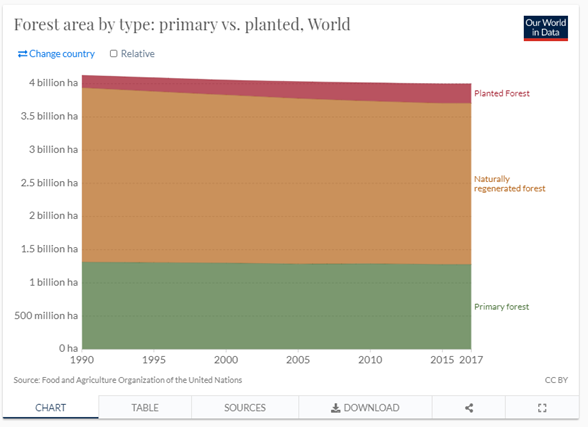Protected forests^1
Forests cover 31 percent of the global land area. Approximately half the forest area is relatively intact, and more than one-third is primary forest (i.e. naturally regenerated forests of native species, where there are no visible indications of human activities and the ecological processes are not significantly disturbed).
The total forest area is 4.06 billion hectares in 2020.
Creation of protected areas has historically been the forest governance instrument most often adopted to pursue biodiversity objectives. This approach has achieved positive results in terms of conserving species and establishing barriers to the progress of deforestation. Natural reserves alone are not sufficient to conserve biodiversity. They are usually too small, create barriers to species migration and are vulnerable to factors such as climate change. Additionally, protected areas contain only a fraction of existing forest biodiversity.
Globally, 48 percent of the plantation forest estate was for industrial (or production use), 26 percent for non-industrial (or protection) use (fuelwood, soil and water protection other environmental values) and 26 percent was not specified.
 (Image Credit: World In Data ^4)
(Image Credit: World In Data ^4)
Reforestation^1
The area of planted forests has increased by 123 million hectares since 1990 and now covers 294 million hectares, but the rate of increase has slowed since 2010. Approximately 45 percent of the planted forests (or 3 percent of all forests) are plantation forests, i.e. intensively managed forests, mainly composed of one or two tree species, native or exotic, of equal age, planted with regular spacing and mainly established for productive purposes. The other 55 percent of planted forests, "Other planted forests", are forests that can resemble natural forest at stand maturity and include forests established for ecosystem restoration and protection of soil and water.
Forest restoration can have a variety of objectives relating to reversing land degradation or loss of productivity of ecosystem goods and services such as food, biodiversity and water. These include: - rehabilitation: restoration of desired species, structure or process to an existing ecosystem - reconstruction: restoration of native plants on land used for other purposes - reclamation: restoration of severely degraded land devoid of vegetation and - replacement: the most radical form of restoration, in which species or provenances maladapted for a given location and unable to migrate are replaced with new vegetation as climates change rapidly (Stanturf, Palik and Dumroese, 2014).
Potential for reforestation: A recent study estimated that there are some 1.7 billion to 1.8 billion hectares of potential forest land (defined as land that could sustain more than 10 percent tree cover) in areas that were previously degraded.
The worldwide gain in forest cover totalled 5.2 million hectares per year, the aggregate of afforestation (1.6 million hectares per year) and natural expansion of forests (3.6 million hectares per year).
Carbon storage
The intensity of the metabolic processes in trees depends not only on their age but also on certain environmental factors, such as density, temperature, humidity, availability of nutrients, and presence of weather anomalies. There are so many variables that any estimates as to the amount of CO2 absorbed by forests are beset with uncertainty. Consequently, there is a risk that important political decisions regarding climate change mitigation will be based on uncertain predictions.
A tree absorbs 30 kgCO2 per year in average ^2. The world mean density of trees per hectare is 225.40[3].
This leads to a result of 6762.1 kg CO2/ha/year.
Data
Information regarding the age distribution of planted forests comes from Our World In Data^4. An average lifetime of forest has been taken at 150years (corresponding to the age of a tree). Investments are taken to corresponds to actual trend of 1.6Mha new planted forests each year.
^1: Food and Agriculture Organisation of the United Nations, http://www.fao.org/documents/card/en/c/ca8642en ^2: ecotree, https://ecotree.green/en/how-much-co2-does-a-tree-absorb ^3: OurworldInData, Number of trees per km2, 2014, https://ourworldindata.org/grapher/number-of-trees-per-km?tab=chart&country=World+%28mean%29~FRA~RUS~USA ^4: OurworldInData, Primary vs. planted forest, https://ourworldindata.org/forest-area#primary-vs-planted-forest